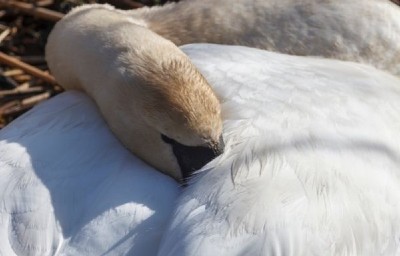How and where do swans sleep? Are they nocturnal? These graceful and majestic creatures sleep on both land and water. They sleep mostly between sunset and sunrise in their natural habitat and can do so standing on one leg or floating with their heads tucked under their wing. Do swans sleep in the water at night? Yes, they normally gather in the water at night to protect themselves from predators, like marauding foxes.
Where Do Swans Sleep?
Although swans are waterfowls, they can sleep in a variety of environments. When they sleep on land, they stand on one leg and float in the water with their beaks folded away between their wings. While these positions do not seem comfortable for humans, they are ideal for a nice long sleep for these birds.
Where Do Swans Sleep in the Winter?
During winter, swans migrate to areas with milder climates. They leave their natural habitat before the water in the lakes and rivers freezes to find open water. Some may migrate further than the others but just far enough to survive the winter months. As the temperature decreases, they spend more time sleeping. So, the gentle birds fly to areas where the air temperature is not cold enough for them to freeze to death.
Where Do Swans Sleep at Night?
Most of the time, swans sleep at night right in the water, floating with their heads tucked back under their wings. Although they are diurnal, they gather in large numbers during the night to keep the bevy safe from potential predators. They also fluff up their feathers to cover their body while sleeping to keep the temperature high.
How Do Swans Sleep
Swans have two options for sleeping: standing on one leg on land and floating on water. They fluff up their feathers in both positions to protect their bodies from cold temperatures and predators.
Standing on One Leg
Swans stand on one leg to manage heat loss. Tucking up one foot reduces the heat lost by half through their unfeathered limbs. Since their feet are closer to the environmental temperature, they don’t lose as much heat as their body temperature when sleeping on one leg. During winter, they fluff up their feathers to cover both legs and tuck their beaks under their wings.
Floating on Water
Swans keep off the ground during the night to protect themselves from predators. While floating on water, they can sense the vibration caused by predators swimming towards them. They also often fluff up their feathers to cover their bodies for protection and keep their temperature high.
Although these sleeping positions seem uncomfortable, they provide the swans with the warmth and safety they need to survive the night.

Swan Sleep FAQ
Swans swim regularly and usually use the body of water to sleep at night. They also stand on one leg when asleep during the day. Whatever their sleeping position, they gather together on land and in the water to keep themselves warm and stay safe from potential predators.
If you are still wondering how and where swans sleep, everything you need to know about swan sleep is below.
Do Swans Sleep in the Water?
Yes. Swans are water repellent and filled with air, allowing them to sleep on the water. The preen gland or uropygial gland located near the rump secrete the oil that lets them stay afloat even when asleep. Then, they propel their legs as they rest their heads under their wings.
Swans are very light sleepers. They are easily awakened with the least amount of noise and movement. They may appear fully asleep, but they are always alert. Plus, they gather in the water during the night to protect themselves from predators.
Where Do Baby Swans Sleep at Night?
Baby swans called cygnets do not leave the nest for around two to three days. During this time, they will sleep on the soft down of their mothers. After that, they huddle together, resting their heads on another’s body, when settling down for a night’s sleep. They also nearly always sleep in the water. They rest on the back or in the wing of their parents until they are safe to sleep on their own.
Why Do Swans Sleep on One Leg?
Swans sleep on one leg on land and in the water to minimize excessive heat loss. They rest one leg in their feathers to keep it warm while the other maintains balance. They alternate which leg gets tucked to make sure one leg stays warm. In this way, they are able to control their body temperature.
Are Swans Nocturnal?
No. The swans are mostly diurnal. They exhibit some flexibility in timing, meaning they migrate by both day and night. They can fly long distances between water bodies at night or float in the water sleeping.
Final Words About Where Do Swans Sleep
Knowing how and where do swans sleep allows you to understand their behavior. These birds are diurnal, which means they can be active both day and night. They are not nocturnal. Some sleep in the water at night, while others migrate.
Swans have two sleeping positions: standing on one leg or floating in the water. They usually gather together in the water at night to keep the bevy safe from marauding foxes and other predators. On the other hand, the cygnets sleep on the back or in the wing of their parents until they can safely sleep independently.
Although considered as waterfowls, swans can sleep in both land and water. They are comfortably found in lakes and rivers as these graceful creatures can swim and fly with incredible speed and agility. They leave their natural habitat to find areas with milder climates and open water in the winter.
Table of Contents

